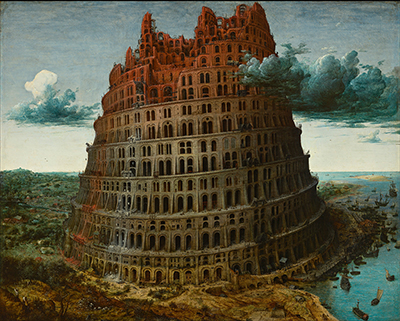The Little Tower of Babel is one of a series of three paintings by Pieter Bruegel the Elder in around 1563
The most famous version is to be found in Vienna (Kunsthistorisches Museum) and is sometimes referred to as the Great Tower of Babel in order to differentiate it from the painting that you find here. This one is now to be found in the Dutch city of Rotterdam, at the Museum Boijmans Van Beuningen. The third of this series was sadly lost, having earlier been completed in Rome, with Bruegel choosing to complete that work on ivory, where as the other two larger pieces were on wooden panels.
The two surviving works are both dated at circa 1563, with the larger one being around twice the size of the smaller, measuring 155cm × 114cm. The similarities between the content in both is obvious, but these are by no means copies of each other. There are differences in the sky, the landscape and the architectural detail, ensuring the two paintings are treatede as separate artworks in their own right.
The building of this tower was described in Genesis 11:4 as a means to drawing a community together, giving them pride and also ensuring that they remained in a relatively close proximity to each other. Besides the tower, which would be the spearhead of this new beginning, would also be a complete city around which a strong community would develop.
The architectural style used by Bruegel in these two paintings is considered by most to be Roman, influenced by his travels to the Papal States of Italy around a decade earlier. It is the arches, in particular, that remind us of Roman colosseums for example. Whilst we do know that Bruegel produced study sketches for his more complex paintings, none still remain today. The drawings that have been attributed to him stand alone as separate artworks.
The Little Tower peaks into the clouds, just as the Old Testament had instructed. The building is incomplete and looks particularly fragile, perhaps a symbol of the futility of the efforts of man within a world ultimately controlled by a greater, divine being. This smaller version is darker than its sister work, making elements of the architectural features harder to see. The sweeping seascape to the right remains much the same.
The detail by Bruegel on the arches and various levels of the tower are also much tighter in this smaller painting. The symmetry across the breadth of the construction looks more carefully planned, be it by the army of workers in the painting, or the artist himself.




